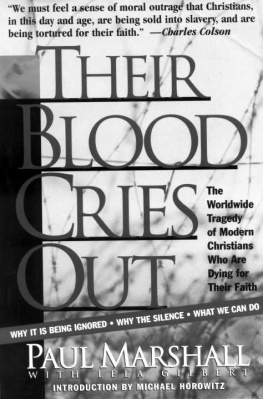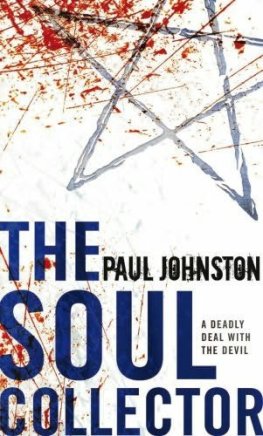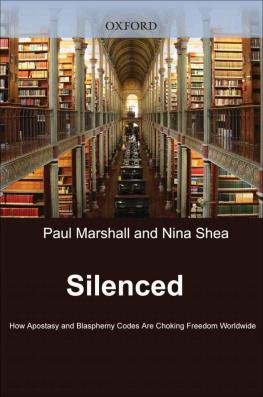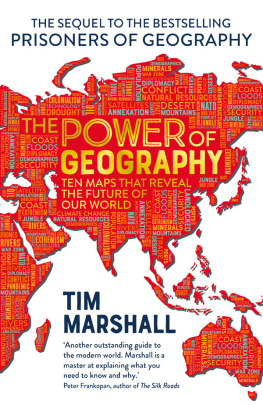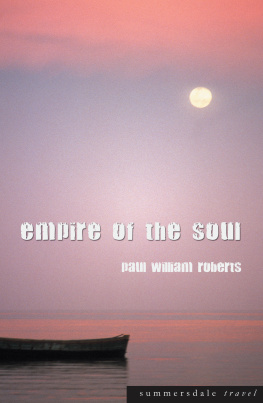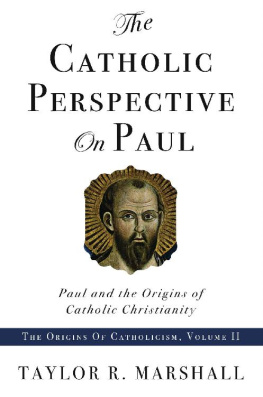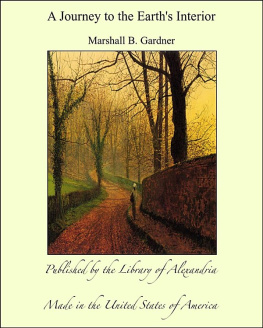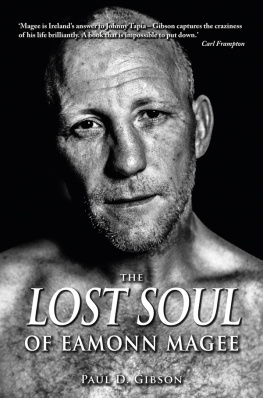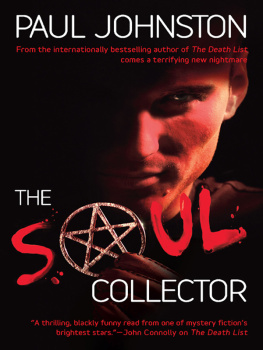Paul Marshall - The Shape of the Soul
Here you can read online Paul Marshall - The Shape of the Soul full text of the book (entire story) in english for free. Download pdf and epub, get meaning, cover and reviews about this ebook. publisher: Rowman & Littlefield Publishers, genre: Religion. Description of the work, (preface) as well as reviews are available. Best literature library LitArk.com created for fans of good reading and offers a wide selection of genres:
Romance novel
Science fiction
Adventure
Detective
Science
History
Home and family
Prose
Art
Politics
Computer
Non-fiction
Religion
Business
Children
Humor
Choose a favorite category and find really read worthwhile books. Enjoy immersion in the world of imagination, feel the emotions of the characters or learn something new for yourself, make an fascinating discovery.

- Book:The Shape of the Soul
- Author:
- Publisher:Rowman & Littlefield Publishers
- Genre:
- Rating:5 / 5
- Favourites:Add to favourites
- Your mark:
- 100
- 1
- 2
- 3
- 4
- 5
The Shape of the Soul: summary, description and annotation
We offer to read an annotation, description, summary or preface (depends on what the author of the book "The Shape of the Soul" wrote himself). If you haven't found the necessary information about the book — write in the comments, we will try to find it.
The Shape of the Soul — read online for free the complete book (whole text) full work
Below is the text of the book, divided by pages. System saving the place of the last page read, allows you to conveniently read the book "The Shape of the Soul" online for free, without having to search again every time where you left off. Put a bookmark, and you can go to the page where you finished reading at any time.
Font size:
Interval:
Bookmark:
Paul Marshall is an independent researcher with interests in mysticism, religion, philosophy, science, and their interactions. He studied Natural Sciences at the University of Cambridge and received his MA and PhD in Religious Studies from Lancaster University. He is author of The Living Mirror: Images of Reality in Science and Mysticism (1992) and Mystical Encounters with the Natural World: Experiences and Explanations (2005). With Edward F. Kelly and Adam Crabtree, Marshall coedited Beyond Physicalism: Toward Reconciliation of Science and Spirituality (2015).
All mean egotism vanishes.
I become a transparent eye-ball.
I am nothing. I see all.
Ralph Waldo Emerson
T HERE IS A TRADITION among poets and artists that we, as jaded adults, have become estranged from the worldcut off from nature, from one another, even from ourselvesthrough deeply ingrained habits of mind that prevent us from seeing things as they really are. Familiarity has bred a lack of awareness, a haze of inattention that conceals the wonder of the here and now, while separative thoughts and evaluations make the world appear fragmented, a heap of isolated pieces divided from one another and from ourselves. But on occasion the fog lifts a little, bringing moments of clarity, reconnection, and wholeness.
So it was that the Romantic poets aspired to see the world anew, vivid, luminous, unified, as some of them had known it in childhood. Wordsworth recounts that as a boy he would at times feel the outside world to be inseparable from himself: I communed with all that I saw as something not apart from, but inherent in, my own immaterial nature. The young Shelley may have known the feeling too, as suggested by his recollections in adulthood of the state of childhood:
Let us recollect our sensations as children. What a distinct and intense apprehension had we of the world and of ourselves.... We less habitually distinguished all that we saw and felt from ourselves. They seemed as it were to constitute one mass.
Shelley explained that the sense of unity is all too easily lost as we grow up. Thinking and feeling become fixed into routines, turning us into automatons, into mechanical and habitual agents. Appreciation of the miracle of existence is lost: The mist of familiarity obscures from us the wonder of our being. Among the Romantics, the recovery of the vision was generally viewed not as a regression to a state of innocence but as an advance, with unity now established in the mature mind, instructed by the lessons of experience. Consciousness develops not along a circle, from unity through division back to the old unity, but along a spiral, from unity to division to a higher unity, with the fall into the stage of alienation making advancement possible. The journey home leads to Jerusalem, not back to Eden.
It is unclear whether any of the Romantics attained the higher unity in an enduring fashion, but one poet and spiritual thinker does appear to have reached the longed-for condition. Thomas Traherne (ca. 16371674), writing over a century before the Romantic movement was properly underway, recalled the loss of his own infant pure and virgin apprehensions, attributing the deprivation to several factors: the poor examples set by others, a host of distractions, and an education that neglected to foster and cherish the vision. Like grit in the eye or yellow jaundice, these had worked to cloud his sight (CM III.5). However, Traherne was to recover the vision, and he set out to communicate it to others and show them the way to their infinitely precious birthright, the divine Image, the soul restored to the likeness of God.
Traherne, the Romantics, and assorted proponents of nonduality look upon our ordinarily confused, divided state of consciousness with regret. The case can be put as follows, although nondualist thinkers will disagree over the details and some major points too. While the discriminations by which we distinguish ourselves from others are often based on real differences and so are largely justified, they are usually applied too severely, taken too far, with the result that the world is construed as a heap of bits and pieces separate from oneself, rather than as an unbroken whole of which all things, including ones thoughts, feelings, and body, are parts and modifications. The tendency toward conceptual fragmentation of the universe, reinforced by the naming of things, and exacerbated by certain atomizing and materializing trends in the history of philosophical and scientific thought, could be called, rather grandly, the miscognition of the continuum as radically discontinuous. The universe so divided is structured dualistically into myself and not-myself, with the two sharply distinguished, a tendency that could be called, equally grandly, exclusive identification with a fragment. In short, divide and misidentify. But sometimes the conceptual impositions cease to dominate, and the world is apprehended in its integrality, with self no longer delimited to a fragment and divorced from the whole.
The important point to appreciate is that the universe is an undivided whole and can be so only if it is experiential in nature, for only an experience can hold together a multiplicity in a true unity. But we habitually misconstrue the world by fragmenting it in our thoughts and feelings into discrete, nonexperiential bits and pieces radically separate from one another. Unlike trees rooted in the soil, we human beings are free to wander about our environments and stake out our little patches. Moreover, being endowed with nervous systems that help define our interiors and surfaces with sensations of various kinds, including pleasures and pains, we very naturally distinguish our bodies sharply from the rest of the world. All this provides the groundwork for highly developed conceptual, linguistic, social, economic, legal, political, scientific, philosophical, and religious ways of carving up the world and setting ourselves apart from it and one another.
This, at least, is one version of the story, and an oft-told story it is too, set forth in the spiritual writings of several cultures, reinvigorated and disseminated by the Romantics, and repeated in modern times with varying degrees of competence by teachers of nonduality. It is sometimes expressed in rather abstract terms but is brought vividly to life by accounts of mystical experience that give a sense of what it is like to apprehend the universe as it truly is, a highly differentiated but nonetheless undivided whole.
How, then, might the world look if the veils of habit, mental distraction, and separative, dualistic mindset were to lift? What kind of perceptual, intellectual, and emotional transformations would clarified engagement with the world bring? Hints can be found in modern-day reports of extraordinary experiences in which barriers between self and world melt away. Surveys have suggested that feelings of unity with the natural world are fairly common. In Andrew Greeleys 1973 US survey, one person in ten had known a sense of the unity of everything and my own part in it. However, studies of this kind have not inquired into the depth and intensity of the feelings, and it is likely that many such experiences are mild compared with the rather dramatic instances I cite below. These examples will illustrate some common features of the more intense experiences but also bring out significant differences. In particular, it is noticeable that some experiences involve perceptual transformations of comparatively limited extent, restricted to the immediate surroundings, whereas others seem to bring expansions of much greater scope and even shifts of consciousness out of the body. Although it is difficult to place these varied experiences into neat categories, a useful distinction can be made between transformed perceptions of the world that continue to draw on the ordinary senses (sensate) and those that seem to reach beyond the senses (trans-sensate). By withdrawing from sensory perception of the world, by turning inward so to speak, one can find the world again but in a richer manner as Traherne put it, recalling his own discovery of the universe within the soul.
Font size:
Interval:
Bookmark:
Similar books «The Shape of the Soul»
Look at similar books to The Shape of the Soul. We have selected literature similar in name and meaning in the hope of providing readers with more options to find new, interesting, not yet read works.
Discussion, reviews of the book The Shape of the Soul and just readers' own opinions. Leave your comments, write what you think about the work, its meaning or the main characters. Specify what exactly you liked and what you didn't like, and why you think so.

